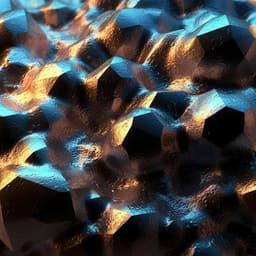
Physics
A Quaternary Mixed Oxide Protective Scaffold for Ruthenium During Oxygen Evolution Reaction in Acidic Media
A. Piñeiro-garcía, X. Wu, et al.
This groundbreaking research by Alexis Piñeiro-García, Xiuyu Wu, Mouna Rafei, Paul Jonathan Mörk, and Eduardo Gracia-Espino introduces a novel quaternary Sn-Sb-Mo-W mixed oxide that acts as a protective scaffold for ruthenium oxide. This innovation enhances the stability of ruthenium during the oxygen evolution reaction, significantly reducing degradation compared to traditional methods.
~3 min • Beginner • English
Introduction
The study addresses the key limitation of PEM water electrolysis: dissolution and degradation of anode electrocatalysts under acidic OER conditions. While RuO2 and IrO2 are highly active, they suffer significant dissolution even at moderate current densities, necessitating a trade-off between activity and stability. Prior approaches include mixed oxides (RuO2/IrO2), RuO2 with earth-abundant oxides, pyrochlores, and perovskites. The authors hypothesize that a multicomponent acid-stable mixed oxide scaffold can host and stabilize Ru, mitigating dissolution by hindering formation of highly reactive high-valence Ru species and providing a durable protective matrix under harsh acidic, high anodic potentials.
Literature Review
The paper reviews supports/frameworks used to stabilize RuO2 for acidic OER, including Sb–SnO2, TaOx, TiO2, WO3, chromium oxides, pyrochlore and perovskite oxides. Earth-abundant mixed oxides that stabilize Ru are highlighted for improved stability, scalability, and cost. Computational and experimental insights indicate combinations such as WOx–MoOx (1:1), SnO2–Sb2O3 (1:1), and WOx–SnO2 (18:1 W:Sn) form acid-stable oxides under anodic potentials. Solution precursor plasma spraying (SPPS) is identified as a scalable route to multi-component oxide coatings. The need to balance conductivity and stability, often requiring substantial noble metal loading (>20 wt%), is discussed as a challenge from prior reports.
Methodology
- Materials: Precursors included SnCl4·5H2O, Na2WO4·2H2O, (NH4)6Mo7O24·4H2O, SbCl3, RuCl3·xH2O. Substrates: FTO glass (7 Ω/sq) and titanium fiber felt (0.2–0.3 mm, 53–56% porosity). Electrolytes: H2SO4 (0.5 M, 0.05 M) for pH 0 and 1; phosphate buffer adjusted to pH 2.
- Mixed oxide synthesis (MO): SPPS using aqueous precursor with Sn:Sb:Mo:W molar ratio 5:5:18:18, total metal concentration 0.1 M. Plasma system: Met-PCC (PLAS) with PL50 pistol, 6 mm nozzle; argon 50.0 NL/min + nitrogen 2.0 NL/min; 500 A (25.5 kW). Precursor flow 15 mL/min, premixed with N2 (3 NL/min). Robot raster: 250 mm/s lateral, 4 mm vertical per turn; 8 cycles/layer; 16 layers; stand-off 200 mm; masked coating area ~1×1 cm2 on 10 substrates simultaneously. Post-anneal in air at 500 °C for 2 h (4.3 °C/min ramp).
- Ru incorporation (Ru-MO): Add 0.25 g RuCl3·xH2O to 100 mL precursor (Ru:Sn:Sb:Mo:W = 1.7:5:5:18:18; total metal 0.112 M; 2.8 wt% Ru in solution). Same spraying, with post-oxidation durations of 2 h, 12 h, and 24 h (samples: Ru-MO@2h, @12h, @24h). Additional Ru-MO deposited on Ti felt with 500 °C/24 h post-oxidation (Ru-MO@Ti). Reference RuO2@Ti prepared from Ru-only solution and same oxidation.
- Characterization: SEM/EDX (Zeiss Merlin), XPS (Kratos Axis Ultra DLD, Al Kα), XRD (PANalytical X’Pert, Cu Kα, 5–75°, 0.01395° step, 0.5 s/step), four-point probe sheet resistance (Ossila).
- Electrochemistry: Three-electrode cell (Pt counter, Ag/AgCl 3 M KCl reference; potentials converted to RHE: ERHE = Ecell + 0.059 pH + 0.210 V).
• MO stability tests at pH 0, 1, 2: 20 CVs (1.2–1.8 V vs RHE, 5 mV/s), followed by 500 CVs (1.2–1.8 V, 100 mV/s).
• Ru-MO activity/stability: 15 CVs at pH 0 (1.2–1.8 V, 5 mV/s). Deactivation kinetics evaluated via second-order rate model 1/ja = kx + 1/ja0 at 1.8 V.
• On Ti felt (Ru-MO@Ti, RuO2@Ti): 15 CVs stress test; extended stability: 2000 CVs (1.2–1.8 V, 100 mV/s), with low-scan LSV (5 mV/s) every 100 CVs and final LSV to 2.0 V. EIS at 1.7 V (1 kHz–0.1 Hz, 10 mV).
• ECSA via double-layer capacitance in 1.3–1.4 V region using varied scan rates and Cspecific = 35 µF/cm2. Mass activity computed from kinetic current and Ru loading.
- Data analysis: XPS fitted in CasaXPS with constrained spin–orbit parameters; EDX for atomic ratios across depth vs XPS surface sensitivity to monitor compositional changes.
Key Findings
- MO stability and composition:
• Mixed oxide (SnOx, Sb2O3, WO3, MoOx) forms porous, semi-continuous coatings with homogeneous elemental distribution. XRD indicates mainly single-metal oxides; XPS shows multiple oxidation states initially (W, Mo, Sn partially reduced) transitioning to higher valences after anodic cycling.
• After stress tests (20 CV @5 mV/s + 500 CV @100 mV/s) at pH 0–2: increased porosity (voids, fissures, hollowed spheres), more pronounced at lower pH. EDX/XPS show W/Mo atomic ratio increases up to ~5.5 as pH decreases, indicating preferential Mo dissolution; Sb/Sn remains ~constant. W/Sb ~3.5 after tests, indicating W, Sb, Sn relatively stable. Ovac/Olattice from O 1s XPS increases with decreasing pH, consistent with Mo dissolution and Na leaching.
- Ru incorporation and deactivation kinetics:
• Ru-MO@12h and @24h on FTO show higher current density (~1 mA/cm2 at 1.8 V) than @2h but overall low current due to low Ru content (2.8 wt% in precursor) and poor conductivity. Sheet resistance: MO 12.2 MΩ/sq; Ru-MO@24h 1.5 MΩ/sq.
• Deactivation follows second-order kinetics at 1.8 V; rate constants: k = 0.067 (Ru-MO@2h), 0.028 (Ru-MO@12h), 0.023 cm2·(mA·min)−1 (Ru-MO@24h). Longer annealing improves stability (better oxide network, fewer Ovac).
• XPS Ru 3d for Ru-MO@24h: before cycling RuO2 (∼280.9 eV) and RuO3 (∼282.4 eV); after 15 CVs, RuO4 (∼283.4 eV) appears, indicating dissolution via RuO2 → RuO4(aq) (Ru+8) under anodic conditions.
• Post-cycling W/Mo ratio increases to ~10; Sb/Sn stays ~constant; Ru atomic ratio decreases, consistent with Ru loss.
- Performance on titanium felt:
• Ru-MO@Ti (2.64 wt% Ru in coating; ~110 µg Ru cm−2) vs RuO2@Ti (similar Ru loading). Ru-MO@Ti displays ~5× higher current at 1.8 V vs RHE than Ru-MO on FTO. ECSA for Ru-MO@Ti: 131.4 cm2. Mass activity: 4440 A g−1Ru @1.80 V; 1620 A g−1Ru @1.70 V; 985 A g−1Ru @1.65 V.
• Tafel slopes: RuO2@Ti 115 mV/dec (water adsorption as RDS); Ru-MO@Ti 234 mV/dec (also likely water adsorption RDS), attributed to low catalyst loading and scaffold conductivity. EIS: similar Ro; larger Rct for Ru-MO@Ti.
• Short-term stability (15 CVs, pH 0): RuO2@Ti loses ~50% current density; Ru-MO@Ti initially increases (surface area gain from Mo/Na leaching), then stabilizes.
• Long-term stability (2000 CVs): Ru-MO@Ti loses only ~20% of initial current density; RuO2@Ti loses ~90%. Chronopotentiometry at 2.5 mA cm−2 for 10 h: Ru-MO@Ti increases by 10 mV; RuO2@Ti increases by ~500 mV.
• Post-test XPS: RuO2@Ti shows RuO4 (Ru+8) before/after testing; Ru-MO@Ti shows only RuO2/RuO3 after 2000 CVs with no RuO4, indicating the MO scaffold suppresses Ru+8 formation. Polarization after 2000 CVs: RuO2@Ti shows Ti passivation features (1.7–1.9 V); Ru-MO@Ti does not, indicating protection of Ti substrate.
Discussion
The multi-metal Sn–Sb–Mo–W oxide scaffold produced by SPPS forms a stable, porous network under acidic, high-potential OER conditions and effectively hosts Ru. While Mo partially dissolves during conditioning (especially at lower pH), this sacrificial behavior increases porosity and ECSA without destabilizing the remaining scaffold (WO3, Sb2O3, SnO2 remain largely intact). Incorporating low levels of Ru into the scaffold reduces sheet resistance and introduces OER activity; the stability of Ru improves with more complete oxidation/annealing of the matrix. Critically, when supported on Ti felt, the Ru-MO scaffold suppresses formation of RuO4 (Ru+8), the highly reactive species linked to rapid Ru dissolution, thereby dramatically improving durability compared to RuO2 directly on Ti. The scaffold also protects the Ti substrate from passivation features, indicating a dual protective role. Although the scaffold’s limited conductivity and low Ru loading yield higher Tafel slopes and lower initial activity, the overall approach significantly mitigates the activity–stability trade-off in acidic OER by stabilizing Ru and extending electrode lifetime.
Conclusion
A quaternary Sn–Sb–Mo–W mixed-oxide scaffold fabricated by SPPS provides an acid-stable, nanostructured protective matrix for Ru during OER in acidic media. The scaffold stabilizes Ru by hindering the formation of Ru+8 (RuO4), reduces oxygen vacancy formation with proper annealing, and protects both the Ru catalyst and Ti felt substrate. Mo dissolution under anodic acidic conditions increases porosity and ECSA without compromising scaffold integrity. Ru-MO@Ti exhibits high mass activity (up to 4440 A g−1Ru at 1.8 V vs RHE) and markedly improved durability, retaining ~80% of its initial current after 2000 CVs and showing minimal potential drift under chronopotentiometry, outperforming RuO2@Ti. The approach is scalable and may be extended to stabilize other earth-abundant OER-active metals (Fe, Ni, Co). Future work should target enhancing electrical conductivity (e.g., higher conductive oxide content or optimized noble metal loading) while preserving stability.
Limitations
- Electrical conductivity of the MO scaffold is low (sheet resistance ~12.2 MΩ/sq; reduced to ~1.5 MΩ/sq with low Ru content), contributing to low current density and high Tafel slopes; improving conductivity without sacrificing stability is ongoing work.
- Low Ru loading (∼2.64 wt% in coating) limits activity; higher noble metal contents (>20 wt% reported elsewhere) generally needed for strong activity enhancements.
- Partial Mo dissolution, while beneficial for porosity/ECSA, alters composition and could impact long-term structural integrity if uncontrolled.
- Structural ambiguity remains regarding precise formation of multi-metallic oxides vs mixtures; XRD suggests mainly single-metal oxides, but multi-metal oxide formation or doping cannot be excluded due to coating complexity.
- Initial use of FTO as substrate imposes conductivity limitations on activity benchmarking.
Related Publications
Explore these studies to deepen your understanding of the subject.







